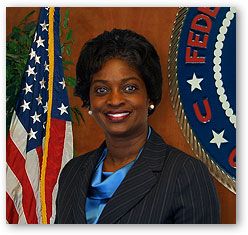Clyburn Gavels Spectrum, Privacy Issues in Debut Heading FCC's Monthly Meeting

Mignon Clyburn, the acting Federal Communications Commission chairwoman, will meet with her counterparts from Mexico and Canada during the next fortnight to examine cross-border spectrum issues that could stem from the planned U.S. auction of broadcast spectrum.
Her personal involvement in the spectrum process surfaced during comments from Gary Epstein, co-head of the Commission’s Incentive Auction Task Force and senior advisor to the chairman, during a discussion with reporters following the first Commission monthly meeting that Clyburn chaired on Thursday, June 27.
Not coincidentally, about half of the session’s agenda items involved spectrum and bandwidth issues. Epstein and his team delivered the first of regular (possibly monthly) updates about the incentive auctions, which are scheduled to begin next year.
Clyburn will attend the International Telecommunications Union’s Global Symposium of Regulators in Warsaw, Poland, next week, where she is scheduled to meet with the head of Mexico’s communications regulatory agency. The following week, she’ll head to Canada for similar discussions, Epstein said.
During his presentation to the FCC – currently operating as a triumvirate of Clyburn, Jessica Rosenworcel and Ajit Pai until the Senate confirms chairman-designate Thomas Wheeler and a Republican commissioner – Epstein explained that the Auction Task force has “accomplished a lot in a relatively short amount of time.” He cited more than 100 meetings with industry and public groups that commissioners and staff have attended to explain the value and process of the spectrum auctions. He also promised that several workshops are “in the planning stages” to prepare for the auctions.
He did not disclose the responses from broadcasters or wireless telecom carriers during these sessions.
After Epstein’s presentations, Rosenworcel urged that the Task Force “should directly reach out to every broadcaster in the top 30 markets in this country. This is where our mobile broadband needs are greatest.”
Multichannel Newsletter
The smarter way to stay on top of the multichannel video marketplace. Sign up below.
Rosenworcel said that the objective should “strive to have a 600 MHz bandplan in place by the end of the third quarter this year.”
She noted that "the road ahead is arduous, the choices hard and important. But the task is also historic. We have an opportunity to lead the world in demonstrating novel ways to reclaim spectrum and repurpose old airwaves for new mobile broadband use. That is epic and exciting.
“I believe we have a mandate from Congress and cannot delay,” she added. “In all of our efforts, we need to keep in mind the power of simplicity in the rules we develop, the need for fairness in our treatment of stakeholders, the balance required in our decision-making, and the essential task of funding public safety.”
She emphasized the need for “transparency,” especially by providing “stakeholders with an opportunity to connect directly with decision makers.” She stressed that such outreach “requires” connections with broadcasters that “is not just broad, but also targeted.”
In his presentation, Epstein described software that can handle a variety of data variables, such as terrain, population and other factors that affect the value and capabilities of spectrum. He cited “realistic, consistent modeling” that will make available the “maximum amount of bandwidth” for the auctions. More details about repacking will be presented within a few months, Epstein added.
He also assured the commissioners that the repacking will not interfere with “stakeholders or the public interest.” And he indicated that spectrum in rural markets will not be repurposed.
Clyburn acknowledged Epstein’s recommendation for “channel sharing” and indicated that the FCC is prepared to authorize channel sharing tests.
Also on Thursday’s FCC agenda were plans for “modernizing” and streamlining the Commission’s process for collection of broadband subscription and deployment data. Clyburn characterized the national broadband map, maintained by the National Telecommunications and Information Administration, as a “critical resource for our nation,” and she thanked NTIA’s “fantastic work” in compiling and maintaining the collection of data for “policy making purposes” for industry and rate-payers.
The commission also reviewed an update of telecom carriers’ use of Customer Proprietary Network Information (CPNI) as established in the 1996 Telecommunications Act. Responding to a staff member’s observation that the last FCC review was in 2007 when “smartphones were in their infancy,” Clyburn declared that the commission’s update assures “appropriate protection against unauthorized action” for data via wireless devices, and she added that the “Commission stands ready to enforce” its new rules. Commissioner Pai added that there should be “no wireless exception to the CPNI rules” and that being “located on a mobile device” should not exclude privacy protections.
The FCC also adopted a Report and Order that will add 10 megahertz to the wireless broadband inventory for flexible use services in the “H Block” spectrum (1915-1920 MHz and 1995-2000 MHz) for commercial licensing. The ruling establishes that the bandwidth will be licensed on an “Economic Area basis” and auctioned through a system of competitive bidding.
Ruth Milkman, chief of the Wireless Telecommunications Bureau, said she expects 10 MHz of spectrum will be available for use – including for mobile broadband – with a target of February 2015.
Contributor Gary Arlen is known for his insights into the convergence of media, telecom, content and technology. Gary was founder/editor/publisher of Interactivity Report, TeleServices Report and other influential newsletters; he was the longtime “curmudgeon” columnist for Multichannel News as well as a regular contributor to AdMap, Washington Technology and Telecommunications Reports. He writes regularly about trends and media/marketing for the Consumer Technology Association's i3 magazine plus several blogs. Gary has taught media-focused courses on the adjunct faculties at George Mason University and American University and has guest-lectured at MIT, Harvard, UCLA, University of Southern California and Northwestern University and at countless media, marketing and technology industry events. As President of Arlen Communications LLC, he has provided analyses about the development of applications and services for entertainment, marketing and e-commerce.

